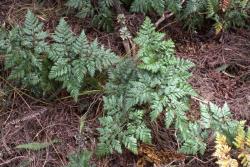- Taxon
- Gallery
- = Davallia tasmanii Cheeseman, Trans. & Proc. New Zealand Inst. 23: 416 (1891) nom. illeg., non Davallia tasmanii Field 1890 – as D. tasmani
Epiphytic or terrestrial ferns. Rhizomes long-creeping, up to 175 mm long (in herbarium specimens), 3–7 mm in diameter, with stipes arising 5–35 mm or more apart; densely scaly. Rhizome scales narrowly ovate, 6–12 mm long, 1.0–1.5 mm wide, peltate, with pale margins and dark brown centres, bearing setae along both margins and multiseptate hairs either along both margins or restricted to the apex. Fronds 110–370 mm long. Stipes 35–175 mm long, red-brown proximally, sometimes becoming yellow-brown distally; bearing scattered narrowly ovate scales up to 5 mm long and 0.5 mm wide, with pale margins and dark brown centres, toothed and with multicellular and glandular hairs on their margins. Rachises red-brown or yellow-brown or pale brown, winged in distal half, sulcate, bearing scattered ovate scales up to 2 mm long and 0.5 mm wide, with abundant long multicellular hairs on their margins. Laminae 3-pinnate to 4-pinnate-pinnatifid, but usually 3-pinnate-pinnnatifid, deltoid-pentangular or broadly ovate or broader than long, tapering to a short pinnatifid apex, 50–210 mm long, 67–255 mm wide, yellow-green on both surfaces, coriaceous, bearing ovate or broadly ovate scales up to 1 mm long and 0.5 mm wide with abundant marginal cilia. Primary pinnae in 7–12 pairs below pinnatifid apex, overlapping, winged except proximally; the distal primary pinnae pinnatifid and narrowly ovate; the proximal pair the largest, broadly ovate and divided into secondary pinnae, 41–142 mm long, 25–115 mm wide, apices acute, bases stalked. Secondary pinnae ovate, narrowly winged, decreasing markedly in length along each primary pinna to its apex; the basal basiscopic one the largest, 18–83 mm long, 9–56 mm wide, apices acute, bases stalked, divided into tertiary pinnae. Tertiary pinnae ovate, winged; the longest at or near the bases of the secondary pinnae, 6–35 mm long, 4–19 mm wide, apices acute or obtuse, divided halfway to all the way to the midrib, bases stalked. Quaternary pinnae ovate, up to 12 mm long and 5 mm wide, sometimes divided more than halfway to midrib. Ultimate fertile lamina segments truncate or bidentate; ultimate sterile segments acute or obtuse. Sori oblong, terminating veins just inside pinna margins; indusia oblong or elliptic, attached at base and along both sides forming a deep pouch, 1.2–2.0 mm long, 0.8–1.4 mm wide, apex ± truncate or slightly rounded.
| 1 | Rhizome scales bearing multicellular hairs along both margins | subsp.tasmanii |
| Rhizome scales bearing multicellular hairs only at their apices | subsp.cristata |
Davallia tasmanii is readily distinguished from the two naturalised species in New Zealand by the presence of multiseptate hairs on the rhizome scales. It is further distinguished by its indusia, which are oblong, attached along all of both sides, and truncate at the apex (von Konrat et al. 1999, fig.3), whereas in D. griffithiana they are obovate with rounded apices and only attached along ⅔–¾ of both sides (Nooteboom 1994, fig. 12), and in D. trichomanoides they are narrowly oblong and truncate or slightly rounded at the apices (Nooteboom 1994, fig. 30).
North Island: Northland.
Three Kings Islands.
Altitudinal range: 30–300 m.
Davallia tasmanii is known only from the Three Kings Islands and from one site in Puketi Forest, Northland.
Davallia tasmanii is primarily a terrestrial species found on rocky banks, rock outcrops and scree slopes in exposed situations or under coastal scrub. Occasionally it is also found as an epiphyte.
| Category | Number |
|---|---|
| Indigenous (Endemic) | 2 |
| Total | 2 |
The publication of the name Davallia tasmanii by Field (1890) predates that of Cheeseman (1891) by a few months and is the earliest name for this species.
Nooteboom (1994) noted that D. tasmanii closely resembled D. canariensis from North Africa and south-west Europe, and suggested that further research was needed to determine whether it was derived from an early introduction. However, von Konrat et al. (1999) showed that there were many constant morphological characters to distinguish the two species, and Tsutsumi et al. (2016) noted that the two species belonged in different sections of Davallia.




